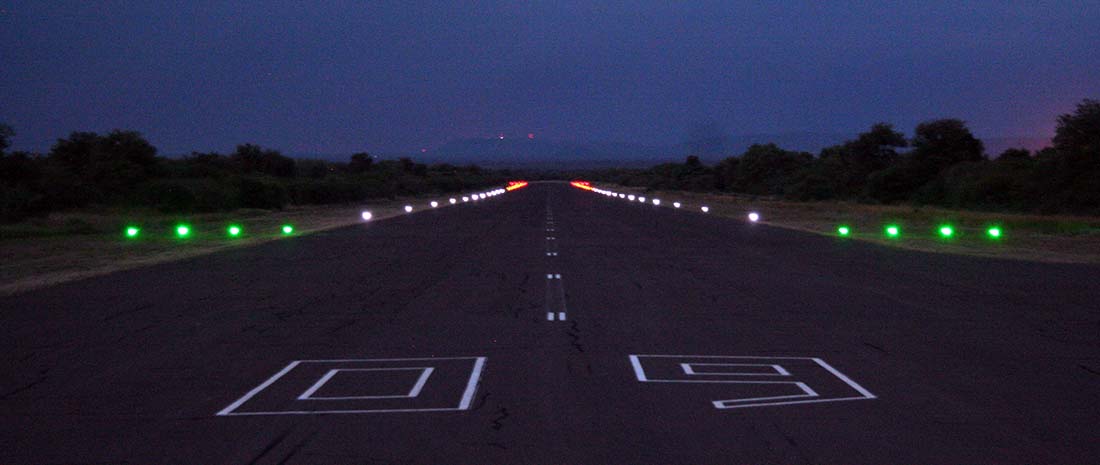Runway Lights: The 4 Cs of Airport Lighting
If you could sum up the most important parts of a plane taking off and landing in four words, they would be the “4 Cs.”
The performance of airport runway lights is comprised of 4 key attributes: configuration, color, coverage and candela. It may sound simple, yet a surprising number of those in the air travel industry don’t understand how these elements combine to form a runway lighting system.
Who Regulates the Four Cs?
While specific regulations may vary slightly from country to country, the International Civil Aviation Organization (ICAO) studies and issues international airport lighting standards. This organization is a United Nations agency devoted to the safety and regulation of air transport.
In the United States, the Federal Aviation Authority (FAA) governs airport lighting standards. For many airports, including smaller and private fields, these standards are guidelines. If an airport uses federal grants or specific fees to maintain and upgrade their facilities, however, the FAA standards become mandatory.
Airport lighting regulations create a uniform and safe experience for pilots no matter where they fly. And that uniformity starts with the configuration of the airport runway lights.
Configuration
In the context of the four Cs, the runway lighting configuration refers to the distance and spacing of the lights on the runway. Lights must be placed along the entire length of the runway, in two rows parallel to each other across and equal distance from the runway centerline.
Light spacing is an important part of the configuration. For an ICAO instrument runway, the lighting rows should be in intervals of no more than 60 meters. For non-instrument runways, it should be at intervals of no more than 100 meters.
Under the FAA’s lighting standards, runway light spacing is 200 feet for both Instrument Flight Rules (IFR) and Visual Flight Rules (VFR) runways.
Color
The actual color of the runway lighting system is very important. For the most part, runway edge lights are varying shades of white.
Runway threshold lights and markings indicate the aircraft-landing zone. In more than 90% of runways, the threshold is near the physical start of the runway. At airports offering nighttime flights, normal thresholds require red runway end identifier lights (REIL lights) and green runway threshold lights.
In less than 10% of all airports, an obstruction or environmental concern may shift the preferred landing zone, otherwise called a displaced threshold. When the touchdown zone is not near the physical start of the runway, runway landing lights between the displaced threshold and where the runway begins should show red on the approach.
Additionally, the take-off area may show yellow lighting.
Safe runway lighting involves keeping the lighting colors simple and consistent. And this creates the kind of safe environment that pilots and passengers deserve.
Coverage
Simply having the right light spacing and color outputs is not enough to create a safe airport runway lighting system. You must also ensure that you have proper coverage from those lights.
On the most basic level, this means your lights must be visible from 0 to 15 degrees to help pilots take off or land. Lights intended to help pilots with circling need to be visible from all possible azimuths.
In order to get the angles right, runway lights must show at angles of 15 degrees above the horizontal. On top of that, lighting must have the requisite intensity to be fully visible during your current lighting and weather conditions.
Candela
How do you know you have the right level of light intensity for your runway? The lighting candela determines intensity. Under both ICAO and FAA standards, the recommended intensity varies based on the type of runway light. The light’s color also has an impact on the required candela, as its brightness can vary depending on background and time of day.
ICAO runway lights should be a minimum of 50 candela to provide maximum visibility for takeoff and landing. If your aerodrome does not have its own extraneous lighting system, you may reduce the lighting intensity to avoid dazzling the airplane pilot. When doing so, though, the lighting must not go lower than 25 candela.
FAA runway light intensities vary greatly depending on the application. On a VFR runway, a red-red bidirectional L-860E runway threshold light requires a minimum average intensity of 5 candela. When operating under IFR, however, the red-red bidirectional L-862E runway end lights require 2,500 candela.
Take Out the Guesswork
Airport lighting regulations are very specific and complex. You don’t want to take any chances with the runway equipment that you purchase. That’s why it’s good to get everything right the first time.
By buying from a trustworthy lighting source, you can get all of your runway lighting supplies from a single source. This provides solid peace of mind while helping to save you both time and money.
Stay Vigilant
It’s important to know that these airport runway lighting regulations could change at any time. Subscribing for FAA or ICAO updates will help ensure you remain informed on current and upcoming changes. Additionally, you should monitor the news for anything that may have an impact on the airline industry.
Runway Lights: Do You Know Where to Go?
Now you know the “four Cs” of runway lights and you know who regulates all of this. But do you know where to go when you need the best lighting equipment?
Peace of mind comes from finding a reliable vendor. This lets you breathe a bit easier with every purchase you make.
Flash Technology specializes in airfield lighting and obstruction lighting, and offers many related training, installation and maintenance services. To see how easy we can make the runway lighting process, contact us today!

